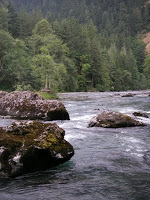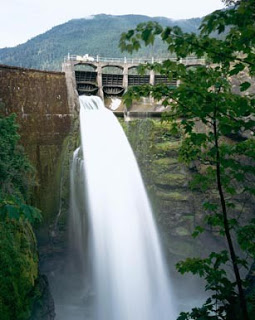According to an article in the current Peninsula Daily News, federal stimulus money has been alotted to get the removal of the Elwha dams underway this summer. The Elwha and Glines Canyon dams were constructed (in 1913 and 1927, respectively), without fish ladders and effectively killed off the most productive salmon run in the State once they had been put in place. Plans to take them down have been the subject of much chatter over the past 10 years or so, but with the incoming cash from Uncle Sugar, the dream is about to become reality.
According to the News: “The $308 million removal project west of Port Angeles will receive $54 million from the American Recovery and Reinvestment Act of 2009 for mitigation projects that will begin this summer. Actual removal of the dams to restore salmon habitat will start in 2011 instead of 2012 — a date the park service had set earlier — and will be completed in 2014 as a result of the new funding.” Originally set to begin in 2004, the project has undergone a variety of changes and modifications to its timeline, but this is the first time the process has been sped up, rather than being delayed.
The current $308 million budget was established in 2008, and by 2014 could rise to $354 million to cover inflation and potential unanticipated, higher costs. (Why do they call them unanticipated, when they are clearly anticipating that they will occur?) The jobs will be welcome – in March, Clallam County’s unemployment rate climbed to 11.3 percent, and Jefferson County’s to 9.5 percent – and although the total number of jobs that will be created by the project is hard to predict until the actual removal contract is signed, the expected impact on local pocketbooks is expected to be considerable.
On the lake floor at the bottom of Lake Mills is a pile of mud. since its construction, the Glines Canyon Dam has

trapped the sediment running down from the high country and held 18 million cubic yards of the stuff behind 210 feet of concrete. When the dam is gone, the fine particles will leave with the new-flowing water, while the heavier, stickier gunk will take between 8 and 10 years to wash away. For the salmon return to happen, the river’s gravelly course will need to reappear through the muck that has accumulated. The Department of the Interior predicts that the fish will start to come back in force within 20 years, and that up to 400,000 will return within 30 years. The Elwha watershed includes 75 miles of rivers and streams.
It’s good news for fish and the people who love them. These dams, like so many others, have had unintended consequences to the point that it has been obvious for a long time that they never should have been built. It’s hard to know for sure all of the consequences that removal will bring, but it’s got to be better than what we’ve got now.
 trapped the sediment running down from the high country and held 18 million cubic yards of the stuff behind 210 feet of concrete. When the dam is gone, the fine particles will leave with the new-flowing water, while the heavier, stickier gunk will take between 8 and 10 years to wash away. For the salmon return to happen, the river’s gravelly course will need to reappear through the muck that has accumulated. The Department of the Interior predicts that the fish will start to come back in force within 20 years, and that up to 400,000 will return within 30 years. The Elwha watershed includes 75 miles of rivers and streams.
trapped the sediment running down from the high country and held 18 million cubic yards of the stuff behind 210 feet of concrete. When the dam is gone, the fine particles will leave with the new-flowing water, while the heavier, stickier gunk will take between 8 and 10 years to wash away. For the salmon return to happen, the river’s gravelly course will need to reappear through the muck that has accumulated. The Department of the Interior predicts that the fish will start to come back in force within 20 years, and that up to 400,000 will return within 30 years. The Elwha watershed includes 75 miles of rivers and streams.










